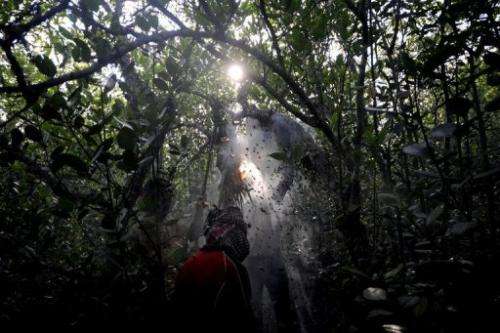Cameras to track tiger numbers in Bangladesh census

Bangladesh is to launch a census of tigers next month living in the world's largest mangrove forest in a bid to determine the full extent of the threat to their survival, scientists said on Tuesday.
Yunus Ali, head of the forestry department, said conservationists would fan out across the Bangladeshi side of the Sundarbans to install cameras on trees to obtain a more accurate estimate of tiger numbers since the last census in 2004.
That survey estimated that 440 Royal Bengal Tigers were on the Bangladeshi side. The forest, which includes parts of India's West Bengal state, spans a total of 10,000 square kilometres (3,860 square miles).
But some experts have criticised the methodology used last time around, which relied on the tracking of footprints and, together with a real decline blamed on poachers, believe the current figure could be less than half that amount.
The Bangladeshi scientists will be assisted by wildlife experts from the US-based Smithsonian Conservation and Biology Institute, Ali told AFP Tuesday.
Scientists hope the cameras will help them compile a more accurate figure over the next two years.

"The pugmark (tracking) system created controversies. It's not reliable," Ali said, adding that the new survey should "end all the debate".
Monirul Khan, a zoology professor at Bangladesh's Jahangirnagar University and the nation's foremost tiger expert, expected the survey to confirm his fears that there were no more than 200 tigers on the Bangladeshi side.
"Camera trapping is a far better and more widely accepted technique. If it is done scientifically, it can give an accurate result," he said.
Khan said that around five tigers were killed every year either by villagers trying to protect themselves or by poachers who then sell on their skins or even body parts which are prized in Asia as an aphrodisiac.
There are around 1,850 Bengal tigers living in the wild, according to the WWF conservation group, including around 1,300 tigers in India.
A census on the Indian side of the Sundarbans, conducted between 2003-04 put the numbers at around 270, although some experts say the real figure is actually less than 100.
A similar survey is currently under way in the Tarai Arc Landscape, a forest region which straddles Nepal and India.
The WWF says tigers worldwide are in serious danger of becoming extinct in the wild. Their numbers have fallen from 100,000 in 1900 to around 3,200 now.
(c) 2013 AFP
















